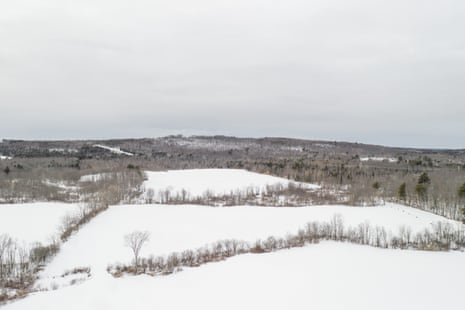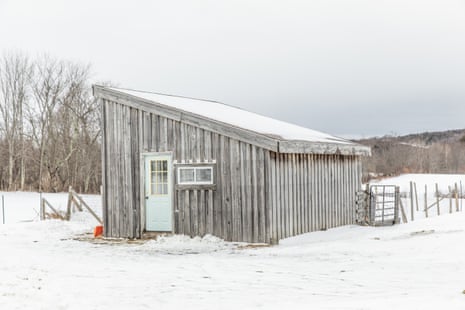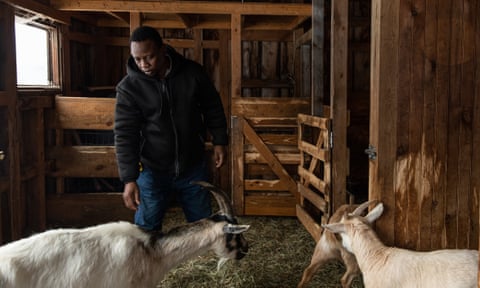Muhidin Libah stretched his arm overhead, tapping the head of a corn stalk and sending its leaves quivering in the August sun.
“About seven feet,” he guessed, comparing the plant to his 5ft 6in frame. Corn was one of the first vegetables he and about 40 other Somali Bantu families planted when they began farming in Lewiston, Maine, in 2014. That was a decade after Libah had landed in the United States as a refugee, and 23 years after he’d been forced to flee Somalia’s Jubba valley.
“I love corn,” he said. Ground down, it can be used to make injera, a spongy flatbread that came to Somalia from Ethiopia; muufo, a drier fermented flatbread; soor, a corn grits porridge known as ugali in Kenya; or dozens of other dishes from Africa. “We’re always trying to recreate the lives that we had back home.”
Libah’s community began arriving in Lewiston, an ageing mill city of 36,000 in America’s whitest state, in 2001. Today, their population measures 3,000, but their quest to make a true home was ongoing until September, partly because farming is a key feature of the Somali Bantu way of life, and their long-term access to farming land had been uncertain. When they first arrived, “We could see all this green land, all these farms,” Libah told me. But it was beyond their reach. “We did not know where to start,” he said. “We did not know who to contact. We did not have any money.” Since 2014, the community has had to re-establish itself on rented plots six times.
The Somali Bantu farmers shared this struggle for land security with small farmers across the US. Speculation on farmland, coupled with rising demand from developers, has translated to swelling purchase prices and rents for tenants. Farmland is also being concentrated in fewer hands as many farmers retire without heirs to carry on their profession. An estimated 371m acres (150m hectares) of farmland – equivalent to nearly all the cropland of the lower 48 states – is expected to change hands by 2035. But with limited access to capital, credit and other aid, small farmers such as Libah and his community have little hope of getting their hands on those acres.

A new effort, which seeks to develop “commons”, hopes to change that. The term describes resources that are not owned by anyone – much like air, water and the internet – but are jointly managed and stewarded by those who have a stake in it. In May, the New Hampshire-based Agrarian Trust, a non-profit organization seeking land access for the next generation of farmers, launched a national network of Agrarian Commons. Each of the 10 regional commons, established across eight states, will hold land parcels in trust, and be controlled by the farmers and local organizations. The sole tenant of the Little Jubba Central Maine Agrarian Commons is Libah’s Somali Bantu community. Two decades after arriving in Maine, they are putting down permanent roots.
Elusive land ownership
Until now, Libah and other Somali Bantu families tended plots on lands they leased, at market rates, from private landowners. Their main 35-acre plot, just outside Lewiston, was composed of 40 community gardens – about a tenth of an acre for each family – surrounding 11 larger commercial plots. There, iskashito groups grew tomatoes, eggplant, kale, collard greens and other vegetables to sell at farmers markets or at wholesale to local kitchens and pantries. The Somali word means “cooperative”, a traditional practice in which a few farmers work a single plot together, sharing labor and profits equitably. An additional 150 Somali Bantu farmers had community plots at two nearby sites, in Auburn and Greene.
Farming is central to Somali Bantu culture. Libah’s community hails from Somalia’s lush Jubba valley, where the weather was temperate, the soil so rich it was practically self-fertilizing, and the Jubba river provided an endless gift of water. “All you needed to do was clear the land,” said Libah. Mammoth fish, like catfish, crowded the river. Hyenas and lions lounged along the road from home to the family farm, interspersed with grazing antelopes, and land was abundant. At age six or seven, Libah began working on one of his father’s 12 farm plots, chasing away small white monkeys. The community farmed to feed themselves, and unloaded any excess at the market. “We’ll sell it to you if you have the money. If you don’t have money, we give it to you,” he recalled.

This came to an end in 1991, when opposition groups overthrew Somalia’s military junta and civil war broke out. Vulnerable to clan militias, about 12,000 Bantu people – an ethnic minority descended in part from slaves brought to Somalia from south-east Africa in the 19th century – fled to a refugee camp in Kenya. Nearly a decade later, some returned to Somalia, but many were resettled by refugee organizations in American cities, including Atlanta and Chicago. Repelled by the drug use, crime and flagrant consumerism they observed, the family-oriented Muslim immigrants soon sent scouts across America in search of a cheaper and safer place to live. They found Lewiston in 2001.
Somali Bantu families began flocking to Maine. At first, people in the community had to rely on food stamps and church pantries, and some locals complained the immigrants were freeloading and draining the public coffers. In 2002, Lewiston’s mayor asked Somali leaders to stop encouraging others to emigrate, drawing national attention and inciting the fury of America’s white nationalists – a group of them even travelled from Wyoming to protest against the Somalis’ presence.
Libah arrived in Lewiston in 2005, after 13 years in the Kenyan refugee camp and one year in Syracuse, New York. Soon after settling in Maine, he founded the Somali Bantu Community Association, where he still serves as director, and the association still helps people with everything from reading their mail to navigating IRS audits. With time, the community began to feel accepted. They found jobs, shopped at local stores, attended schools and colleges.
Yet farmland remained elusive. Libah found the leasing process confounding, filled with sudden reversals that, even with hindsight, he does not understand. Once, a landowner told Libah that he admired the work of the association and was willing to lease part of his property, only to rescind his offer. “You go and walk the property and get excited, and the next day you call the person, who will tell you, never call me again,” he recalled. The group toured another property only to be informed the following day that the offer was off the table and had been rescinded. “I didn’t know what was happening behind the scenes,” he told me, “but something was wrong.” Absent other explanations, he believes that it was racism.
Then, in 2014, a couple in nearby North Yarmouth finally leased them enough land for 20 Bantu farmers. Before long, they outgrew it and transplanted the farm to a parcel in New Gloucester, but in 2015 were asked to leave. They settled next in Turner and Auburn, then Greene and Lewiston, where Libah raises his beloved corn.
“Cultural differences, misunderstandings and miscommunications” had sometimes prompted landlords to terminate the lease, observed Ashley Bahlkow, the daughter of the North Yarmouth couple. She met Libah while working for another refugee farmer program, facilitated the association’s first lease with her parents, and now works for the association. The landlords were well-meaning and supportive of the Bantu farmers, she said, and she thinks they simply wished to expand their own operations, use the land for different purposes, or sell it off for more money than farming could garner. “We live in a system where farmers – their only real asset is their land. When they sell it, that’s what they have for their retirement,” she said. The real problem is “the power dynamic of the land owner, always being the person to decide, ultimately, what happens” to the land.
Tenants have little say. And each move cost the Somali Bantu farmers time and money as they built and rebuilt irrigation systems, prepared soil, and reconfigured subdivided plots, all while riding out the usual vicissitudes of climate and weather. For the iskashito groups, thin profit margins added to the stress: small farmers don’t usually enjoy the heftier profits that larger operations can realize. But the deficits were not limited to the balance sheets. Most of the Bantu farmers – the families tending the community plots – do not grow for income or profit. They feed themselves, and give crates of beans, corn, tomatoes and squash to friends and relatives in Massachusetts, New Hampshire, and upstate New York anytime the community gathers for weddings or funerals.
“If you have land, it’s not only for farming,” said Libah. Land is also a place “where we can exercise our culture” – raucous drumming, dancing, feasting and healing ceremonies – through all the seasons. “It’s also other pieces in the community that we’re missing.”
Little Jubba farms

Libah’s vision of secure land tenure remained a dream until 2019, when a local farmer friend connected him to the farm justice activists of the Agrarian Trust, which exists to tackle one of the most significant barriers for new farmers: a system that commodifies land and concentrates power in the hands of relatively few landowners. Established in 2013 by the Schumacher Center for a New Economics and the non-profit group Greenhorns, which supports young farmers, the trust is guided by the notion that farmland should be held as part of a “commons”.
They used as their building blocks the most well-known model of land commons in the US today: community land trusts (CLTs). Black farmers and civil rights activists pioneered the model in the US in 1969, forming what is widely considered the nation’s first CLT: New Communities. The 5,000-acre (2,000-hectare) farm community that existed in Albany, Georgia, until 1985, collectivized the burdens of land and business ownership, and maximized individual efforts.
Under a CLT, a non-profit organization acquires land – either by purchasing it, receiving it by donation, or acquiring it from the government – then places it in trust, permanently removing it from sale and speculation. The trust is governed in part by its tenants and community members, who decide how to use it, whether for housing, businesses, cultural space, parks, gardens or farms.
Tenants – private homeowners and businesses – then lease the lands for renewable, inheritable 99-year terms, and at below-market rates. But most of the 260 CLTs in the US are concerned with creating affordable low-income housing. “There was just no focus on agriculture,” said Ian McSweeney, the Agrarian Trust’s organizational director.
Trust staff members told Libah that they would fundraise to buy land for the Somali Bantu community to farm, but there was a catch: they would continue to rent the land from the landholder, the newly incorporated Agrarian Commons. “There was a lot of hesitancy from the community to not own the land outright,” recalled Balkhow. But unlike private ownership, CLTs and the Commons democratize control over the land to tenants, including the tasks of budgeting and setting rent. Once Libah and the Somali Bantu farmers understood this, they signed on.
They located a 107-acre farm, complete with weathered plywood barns, for sale in the town of Wales, near Lewiston. The trust raised $367,000 to buy the property, and purchase irrigation, soil and building supplies. In September, the Little Jubba Maine Agrarian Commons bought the land, and in October, the Somali Bantu farmers began migrating to their new home.
The Agrarian Trust has now begun to fundraise for the other nine Agrarian Commons, scattered throughout the continental US, from Tennessee to Montana. Each one is differently composed, depending on the local farmers and the organization spearheading it: in West Virginia, land that a community farm is already leasing from the county government will be placed into the commons; while in Minnesota, farm, environmental and Native justice activists are designing their Commons from scratch. Their eventual goal is “increasing the number of Agrarian Commons across the land, and increasing the landholdings in each of the commons,” said McSweeney. But despite the trust’s paternal role, power is ultimately decentralized to the commons then shared within the community, meaning that each commons will remain locally grounded.
The scale of the effort is notable, said Jim Oldham, the executive director of Equity Trust, an organization that works to protect farmland and keep it affordable. Just a handful of organizations in the US, including Equity Trust, have sought these goals through community control of land, and usually only in isolated cases. Most work to prevent development on farmland by attaching “conservation easements”, a legal restriction, to private property deeds. But the “high visibility, large impact” national network created by the Agrarian Trust has the potential “to do this work at a scale that is meaningful”, Oldham said.

“Making land affordable – that’s one way of addressing the racial wealth gap,” said Neil Thapar, co-director of Minnow, a new land justice project in California. (Thapar gave early advice to the Trust on creating the Commons.) The racial disparities in private land ownership are stark: white farmers own 97% of farms, 94% of farm acreage, and 98% of net farm income in the US today. And the Commons can provide stable land access to “communities of color who are locked out of land ownership”, he said. But while conservation easements are “focused on maintaining individual private property ownership”, CLTs and the Commons are driven by the notion that “land shouldn’t be owned for private benefit or private profit”.
This idea has already compelled others to take up the model. “Ownership gives you permanent power over the land,” said Leah Penniman, a food sovereignty activist and author of Farming While Black, in 2018, as she and her network of Bipoc farmers in the north-east were forming their own commons. “But, to be clear, we don’t believe the land can be ‘owned’,” she said, and she observed that most farmland organizations were “all about preserving the land, not engaging the land for people”.
So with guidance from the Agrarian Trust, they launched the Northeast Farmers of Color Land Trust in 2019, bringing an explicit racial justice focus to the Agrarian Commons model, and tweaking it to include protocols for collaborating with tribes that have historically inhabited the region. “The land question has been at the center of our black liberation movement, and the fact that we needed to acquire and also be thinking about land ownership in a collective way – I don’t think it was ever a question.” A land trust was one of “the ways that a community can collectively build wealth in a way that restores the land and nature”, she said.
And there is much to restore. Intensive industrial monoculture farming is depleting America’s soil, polluting its lands and contributing to an outsized portion of global carbon emissions, thanks to a dependence on global supply chains and chemical pesticides and fertilizers. As Libah sauntered through their Lewiston community plots in August, he pointed to the bean plants interspersed between corn stalks. “When we were in Africa, we always used to do this, but nobody knew the science,” he said. He only learned recently that agronomists also support this method: beans fix nitrogen in the soil, while corn requires nitrogen to grow. It lives in the toolbox of regenerative farming: permaculture, poly-cultures, or agro-forestry, which combine complementary plants, prioritize soil health and even sequester carbon.
Centuries ago, Wabanaki farmers also planted crops in this region in a “three sisters” formation: corn plants next to the beans, with squash or pumpkin offering ground cover and reducing weeds. Now, the Bantu farmers will bring this tradition to their permanent land base in the Little Jubba Central Maine Agrarian Commons.
“Everything is planted in the corn,” said Libah, pointing at the scallions, peppers, cabbage and tomatoes in their midst. All the families grow it. It doesn’t even require irrigation. The iskashito farmers sell it dried to a local tortilla company. But just as land is “not only for farming”, corn is also not just a recipe ingredient or source of nutrition and profits. Libah still remembers the experience of planting his first corn on US soil in 2014. “It was emotional,” he recalled. “I never thought I would put seeds in the ground again.”

This article was amended on 11 March 2021 to clarify the circumstances of the North Yarmouth couple’s move to New Gloucester.









